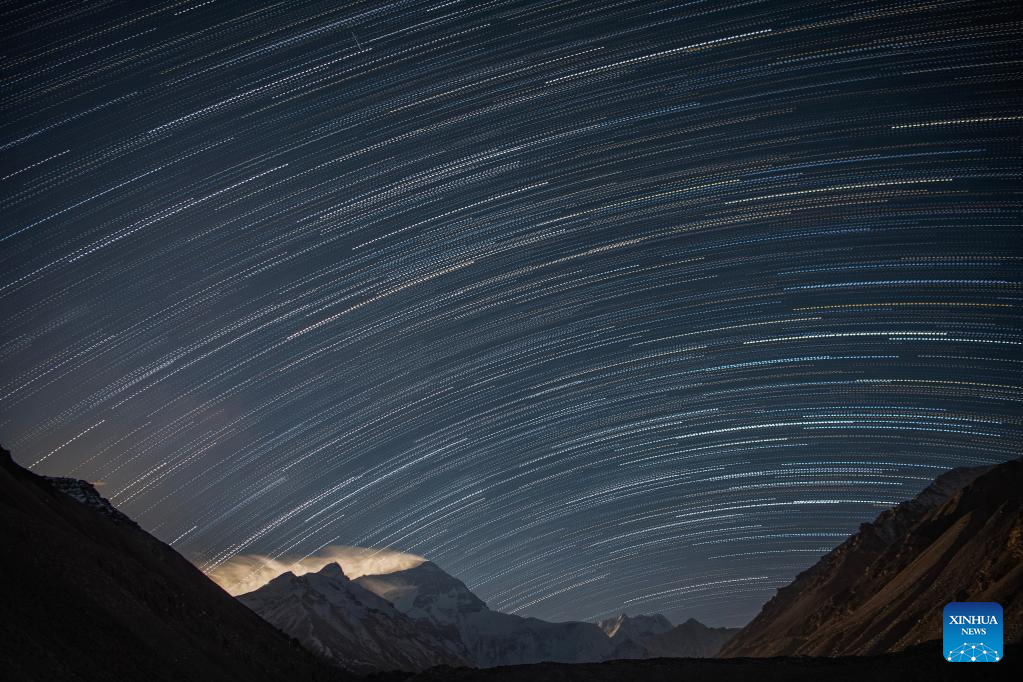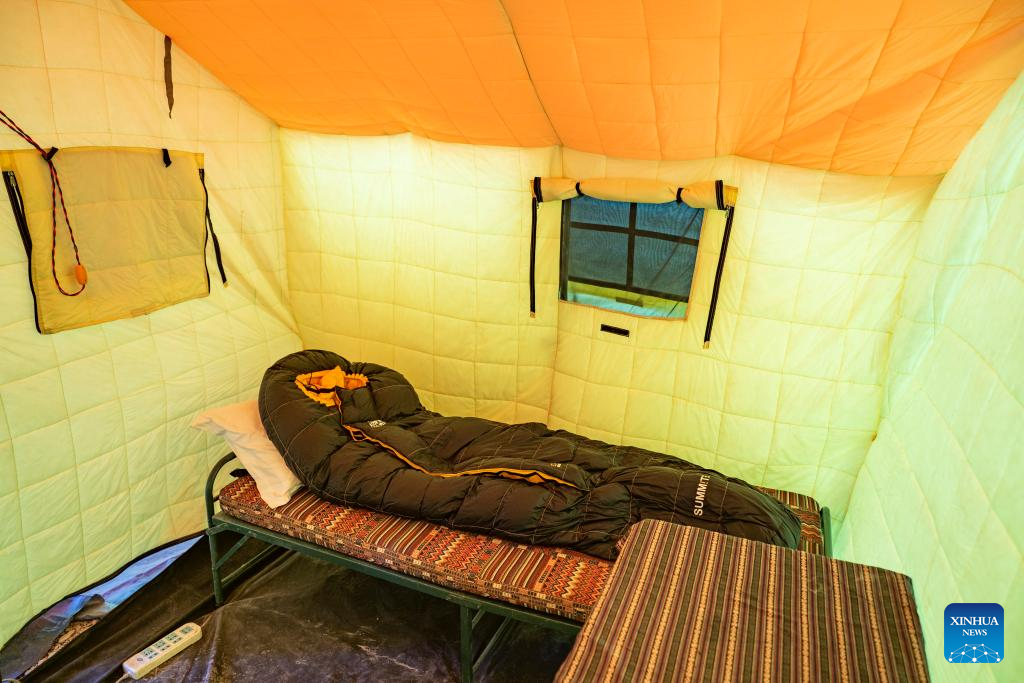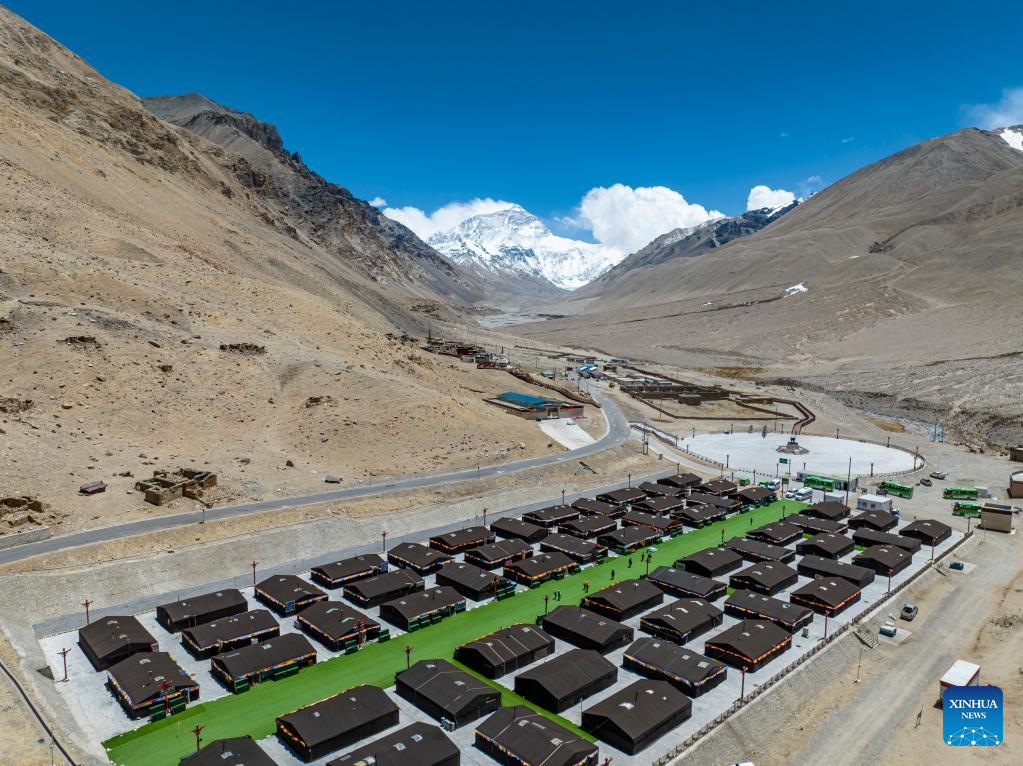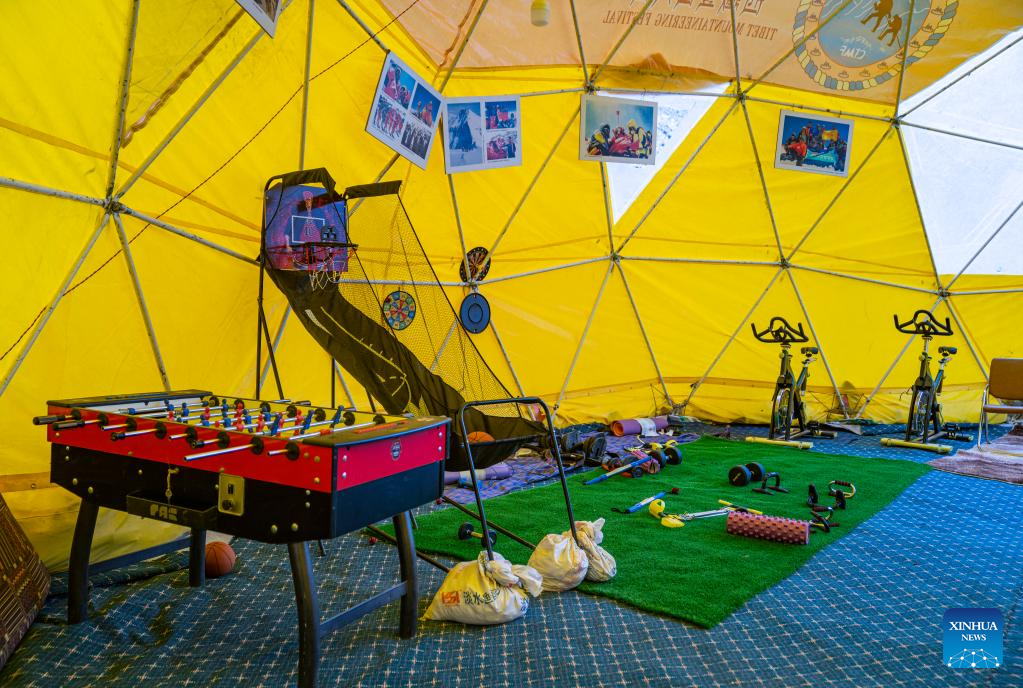
This aerial photo taken on May 9, 2023 shows the mountaineering base camp in the Qomolangma National Nature Reserve in southwest China's Tibet Autonomous Region. (Xinhua/Sun Fei)
by Cao Bin
MOUNT QOMOLANGMA BASE CAMP, Tibet, May 23 (Xinhua) -- Sitting in a tent at the base camp of Mount Qomolangma with a post office next to me, I write this piece recounting my extraordinary first encounter with the highest altitude I have ever experienced.
Situated on the China-Nepal border, the world's highest peak stands tall at a formidable 8,848.86 meters. Climbing it is an immensely challenging endeavor, reserved for the daring and experienced. However, for individuals like myself, visiting the base camp alone provides immense satisfaction.
Here, I can behold the awe-inspiring beauty of the surrounding natural scenery, gaze upon the sacred "mother goddess," as Qomolangma is known in Tibetan, and witness firsthand the unwavering courage exhibited by climbers. This unforgettable experience is one I will proudly recount for a lifetime.
Allow me to provide you with some essential technical details first. There are actually two base camps in the Qomolangma National Nature Reserve, one for climbers and the other for tourists.
The tourist base camp, situated about 5,000 meters above sea level, is an accommodation area comprising dozens of black tents. The tents are usually set up by local people in April and dismantled in October. It is the furthest location that tourists can reach in the reserve.
Based on my personal experience, I can attest that the tourist base camp offers an unparalleled vantage point for capturing breathtaking images of Mount Qomolangma. From this location, the mountain appears towering and majestic, while the picturesque valley in the foreground enhances the overall beauty of the scene.
Armed with a camera mounted on a tripod, I was able to capture an astonishing time-lapse video showcasing the mesmerizing sight of swirling clouds gracefully enveloping the lofty peak. It was truly a remarkable spectacle to behold!
Tourists can spend the night in the black tents and stargaze. Trust me, the celestial panorama above will leave an indelible mark on your memory, offering a captivating display of stars that will forever remain etched in your mind.
About 3 km away from the tourist base camp is the mountaineering base camp, where entry without permission is forbidden. However, as a journalist, I have been granted access as I am tasked with covering the comprehensive scientific expedition on Mount Qomolangma.
Perched at an altitude of some 5,200 meters, the camp finds itself strategically positioned on a relevantly flat terrain, nestled within the sheltered embrace of a gentle slope.
Spread across an expanse akin to half a soccer field, dozens of tents of varying sizes and colors dot the landscape, with the largest one serving as the site for meetings, press conferences and other activities related to the scientific expedition.
One of the large tents serves as a gym and recreation center. Mountaineers can partake in various activities, such as cycling or a friendly game of table football, to maintain their physical well-being amid their rigorous pursuits. This multifunctional tent also houses a cozy café, providing a space for climbers to unwind and refuel, while the smaller tents are used by guides, mountaineers and expedition members to find rest and respite during the night.
When I first arrived here in early May, the base camp greeted me with biting winds and chilling temperatures. In the midst of this inhospitable climate, I witnessed a fascinating sight: wild snowcocks and snow pigeons leisurely strolling just outside the tents, leaping and emitting their distinct calls. Yellow-billed choughs would occasionally alight directly on the scientific equipment carefully arranged by the researchers. An intriguing thing I spotted here was these untamed creatures frequently quenching their thirst beside a barrel, which the canteen staff used for washing kitchenware.
The 5G network coverage at the base camp is amazingly good, and the provision of electricity and heating facilities proves to be highly satisfactory, ensuring comfort and convenience. Along with sufficient oxygen supply, there are also oxygen cubes for those with serious mountain sickness.
It is worth mentioning that all the facilities at the base camp are temporary and will be dismantled when the climbing season is over in June. This is done to protect the environment in the area.
Just last month, China's top legislature adopted a law on ecological conservation on the Qinghai-Tibet Plateau to protect the fragile ecosystem of an area of around 2.58 million square km, with the Qomolangma reserve being an important part of it.
Dondrup, who hails from a nearby village, told me that the regional sports administration has set up an environmental protection team, and he is a team member.
"We patrol from the base camp to the advance camp at an altitude of 6,500 meters almost every day. Now, the place is almost free of garbage," he said.
Regarding the disposal of waste originating from higher regions, Dondrup informed me of an effective system in place. Local guides are paid based on the weight of the mountaineering debris they bring down, containing items like used ropes, tents, gas tanks, oxygen cylinders and batteries. This waste is then transported to the base camp for meticulous sorting and appropriate disposal.
A modest cemetery rests approximately 200 meters to the west, marked by clusters of large and small tillite rocks. These humble formations serve as poignant memorials, paying homage to the courageous climbers who tragically lost their lives. Among the countries represented in this solemn place of remembrance are China, Japan, India, Russia, Australia, the Republic of Korea, and many others.
These symbolic empty tombs tell of treacherous slides and terrifying avalanches. The victims remain forever deep in ice and snow.
As I stood there, contemplating the somber scene, a profound realization washed over me. The recurring stories of successive failures, spanning generations, humbly unveiled to me the true essence of Himalayan mountaineering.
This awe-inspiring pursuit certainly demands utmost resilience and an unwavering commitment to the pursuit of greatness, tempered by the harsh realities and unforgiving nature of these formidable peaks. ■

This photo taken on May 22, 2023 shows an oxygen cube at the mountaineering base camp in the Qomolangma National Nature Reserve in southwest China's Tibet Autonomous Region. (Xinhua/Sun Fei)

This composite photo taken on May 10, 2023 shows star trails above Mount Qomolangma in southwest China's Tibet Autonomous Region. (Xinhua/Sun Fei)

This photo taken on May 22, 2023 shows a small tent used by guides, mountaineers and expedition members for the night at the mountaineering base camp in the Qomolangma National Nature Reserve in southwest China's Tibet Autonomous Region. (Xinhua/Sun Fei)

This aerial photo taken on May 20, 2023 shows the tourist base camp in the Qomolangma National Nature Reserve in southwest China's Tibet Autonomous Region. (Xinhua/Sun Fei)

This photo taken on May 22, 2023 shows a gym inside a tent at the mountaineering base camp in the Qomolangma National Nature Reserve in southwest China's Tibet Autonomous Region. (Xinhua/Sun Fei)



